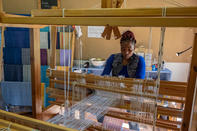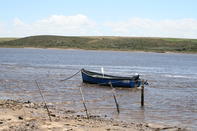Start of the Wool Industry
The lucrative South African wool industry had its start in the Overberg, and Swellendam was its centre - but the town still only had one store, and most of its supplies were brought over the mountains by travelling salesmen.

Then, an enterprising man called Joseph Barry visited the region in 1819, and he quickly fell in love with both the land and a local farmer’s daughter. He resolved to return when the time was right, and settled down in Cape Town to wait for a good business opportunity to present itself.
It came in the unlikely form of a drought that left the Swellendam district destitute and hungry. The government promised to help the struggling farmers, and asked for tenders to carry supplies of rice and grain from the Cape to Swellendam. Since the passage over the Hottentots Holland Mountains was difficult (Sir Lowry’s Pass had not yet been built), Barry had the bright idea of shipping the stuff along the coast to the mouth of the Breede River. From here he arranged ox-wagons to carry the load to Swellendam.
Establishing Port Beaufort

Things went so well for Barry that he soon established a little depot at the river mouth, which he called Port Beaufort. The local farmers were thrilled with this new development, as they could now get their goods to market without having to undertake the gruelling two-month trek to Cape Town. The merchants of Cape Town were similarly delighted, because they could now get their merchandise into the interior. Barry made a packet with his trading venture, and moved to Swellendam in 1824.
For 10 years, Joseph Barry had his ups and downs but by 1834 he had entered into a partnership with his nephews, Thomas and John, and a trading empire was born. By the 1850s, there were branches of Barry se Winkel all over the Overberg, as well as in Cape Town and London. The Overberg farmers stepped up production in light of their new access to markets, and the whole region prospered with ‘Barry and Nephews’ at its heart. Things were going so well that in 1859, Barry and Nephews ordered a brand new screw-steamer from Scotland and, soon enough, the SS Kadie started making regular trips from Cape Town to Port Beaufort. From there, the little steamer chugged up the Breede River to Barry’s newly-established inland depot at Malgas.
The Collapse of Barry and Nephews
This was the golden age of Swellendam, and it seemed as if it would last forever but in 1865, things took a turn for the worse. First, a fire destroyed much of Swellendam, then the brave little Kadie sank when it hit a sandbar at the Breede River Mouth and finally, to top it all off, old-man Barry died. In terms of their original agreement, the partnership had to be dissolved and one third of the company assets paid out to Barry’s heirs. It was all too much for the business to bear and the whole enterprise collapsed. Malgas and Port Beaufort became virtual ghost towns, and Swellendam’s fortunes went into terminal decline.
The Barry’s, however, lived on and today there are hundreds of Barry’s living in South Africa, Germany, Australia, France, Argentina, the UK, the US, Zimbabwe and Namibia. In fact, there are so many descendants that they hold an International Barry Festival every few years, so that the family can stay in touch. The old ‘Barry and Nephews’ store can still be seen on Swellendam’s main road, and the Drostdy Museum has a fascinating exhibit on their local dynasty. Check out that crazy family tree!
 If you’re looking for the perfect weekend getaway in the Overberg region of the Western Cape, accommodation in Swellendam will offer coupl...
If you’re looking for the perfect weekend getaway in the Overberg region of the Western Cape, accommodation in Swellendam will offer coupl...